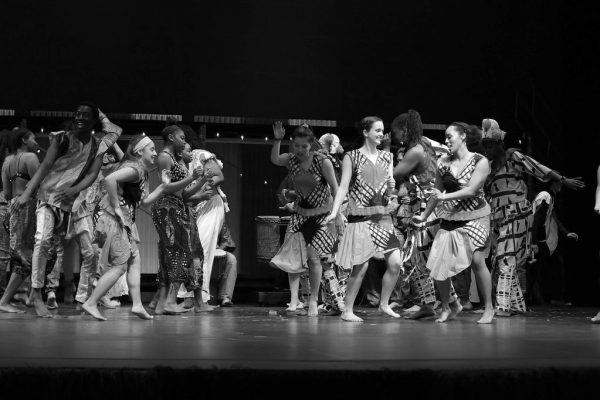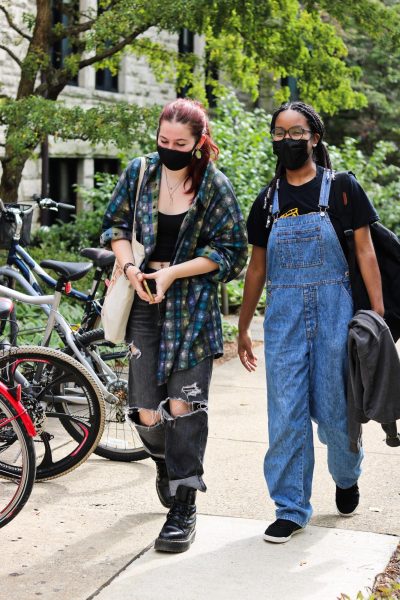A Canadian’s Perspective On The American Multiracial Experience
Before coming to Oberlin, my racial identity was something I rarely reflected on. My mother is a fifth-generation Canadian with entirely European ancestry. My father was born in Jamaica to an English father and a Jamaican mother. The Afro-Caribbean side of my ancestry was discussed comfortably in my family, and I felt no pressure to identify with one race over the other. Regardless of who I surrounded myself with or what activities I was engaging in, I felt like my identity was understood.
When I first came to Oberlin, my identity suddenly became more contentious. I remember my freshman year, I was eating lunch in Stevenson Dining Hall when one of my Black teammates asked me, “What are you?” I explained my genealogy in an abbreviated version of the previous paragraph, and his response was, “So you’re Black, right?” I was confused and taken aback by this statement. How could I identify as Black when I’ve never experienced racism directly? Why do I have to identify as a particular race? Why can’t I just be me?
Since that day, I’ve felt a deeper sense of confusion regarding my racial identity. Having both white colonial ancestry and Black ancestry, I find myself caught between feelings of guilt and feelings of anger. Am I allowed to feel both at the same time? All those questions came bubbling to the surface in my mind without a comfortable space to have those questions answered.
I could ask my white friends those questions, but I fear that my feelings will be invalidated because they see me as white. I could ask my Black friends those questions, but I fear that I will offend them because I am not visibly Black enough; because I have not experienced the trauma of direct, systemic racism. I’ve thought about going to the Multicultural Resource Center multiple times, but talking to other multiracial people brings up underlying fears about the validity of my experience as well. Even if I’m in a space to talk about my background with people who are similar to me, what if I’m not visibly mixed enough for my feelings to be valid? What if I make others feel invalidated by questioning my own experience, when there are others in that group who have experienced racism directly?
I had never considered questions about my identity previously, simply because I didn’t have to when I was growing up; I never felt like it made a difference what my racial background was. In Canada, I felt like I could just be a person and accept my identity without having to choose a side.
Ever since I started living in the U.S., I’ve felt a constant underlying pressure to choose a side. To be white or to be Black. On every form I’ve ever filled out in Canada, I’ve always had the chance to pick All That Apply — Black, White, etc., when asked about my race. On the first form I filled out for my student visa application, they asked me to Pick One — Black, White, or Other. Though I didn’t give it much thought at the time, the very use of the word “Other” demonstrates how the multiracial experience is far more marginalized in the United States than in Canada. Now, when I look at the words “Pick One” with a pen in my hand, I feel like the Other. I feel alienated and ostracized, thrust into a dilemma that I have no solution for.
In the U.S., even random people who have no understanding of my identity want to label me. I remember a vacation to Florida when I was sitting on the beach with my family, a Black man walked past us. I had never met him before. When walking past my less visibly mixed family members he didn’t seem to notice them. When he saw me, he took one look at me, said “My lightskin n*****,” and walked away. My family laughed it off and I laughed with them, but underlying feelings of painful confusion seeped into my laughter.
In Canada, my closest friends and family do not label me. I can’t remember a single experience of being labeled implicitly or explicitly. I always had the autonomy to be myself.
There is no doubt that racism is still present in Canada. Visible minorities are still discriminated against, and significant work needs to be done to promote equality for all races across Canada. In my father’s hometown of Penetanguishene, just two hours north of Toronto, Confederate flags still fly in front of homes where nobody’s ancestors fought in the U.S. Civil War. In the seventies when my father’s family was living there, the town had a population of approximately ten thousand. They were the only family that wasn’t entirely European or Indigenous. Not much has changed since then.
Canada is not perfect. Still, the racial climate in America is still noticeably more polarized than it is in Canada, which makes it far more difficult for multiracial individuals to feel accepted. In Canada, I felt accepted. In the U.S., I feel divided.
The American media’s perception of biracial individuals stokes racial division. The media places additional pressure on biracial people to identify themselves as one race, only. This is yet another heavily racialized aspect of American society that I did not experience in Canada. During my time in the United States, one particular story stood out in helping me understand this dichotomy: the story of Mike McDaniel’s hiring.
On Feb. 6, the Miami Dolphins hired San Francisco 49ers Offensive Coordinator Mike McDaniel as their head coach. In the wake of Brian Flores’ firing and his subsequent lawsuit against the league regarding racial discrimination, McDaniel was the first non-white candidate to be hired as a head coach. However, most people on the internet did not see it that way.
Even though McDaniel identifies as biracial and is proud of both sides of his heritage, Twitter was abuzz with comments claiming that “another white guy” got hired as an NFL coach. Some users even went as far as to request that he post photographic evidence to prove his biracial heritage. News outlets mistakenly labeled him as a white man as well. The sports website Deadspin had to redact an article after telling readers, “Please stop and think before you inadvertently dub another young, white guy as the next hot NFL coaching prospect.”
The internet’s reaction to McDaniel’s hiring is reflective of the racially polarized society the U.S. is today. When I read about the way he was perceived, my feelings about the racial climate in the United States were confirmed. McDaniel’s story is just one of the many examples where American multiracial athletes, politicians, and celebrities are expected to label themselves despite their reluctance to do so.
I hope that someday, space will exist for multiracial Americans to feel accepted and understood the way I was growing up. Multiracial Americans should be given the space to choose not to identify as one race over another, to accept our collective identities as whole. Furthermore, if multiracial Americans choose to identify as one race, they should be allowed to do so under their own volition, free of the racially polarized expectations and perceptions that are so prevalent in American culture.
Thanks to the culture I was surrounded by growing up, I was given the freedom to accept my identity. I was given the opportunity to forge my own path in discovering my identity. Whether I chose to view my identity as holistic or singular was my choice and mine alone. Sadly, I doubt I would have felt the same exploratory freedom if I grew up in America. Every multiracial person’s exploration of their identity is personal, and as such every multiracial person should be given the space to accept their identity as they see fit.




